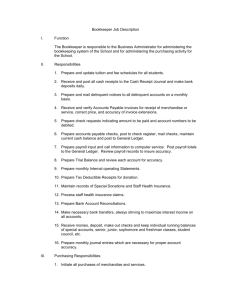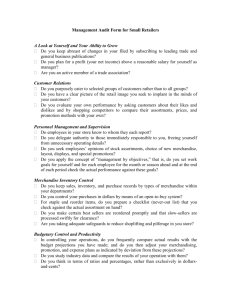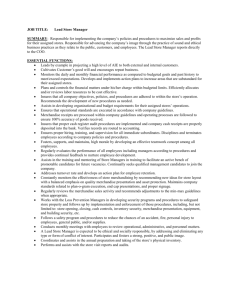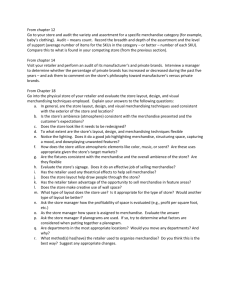Ch_06
advertisement
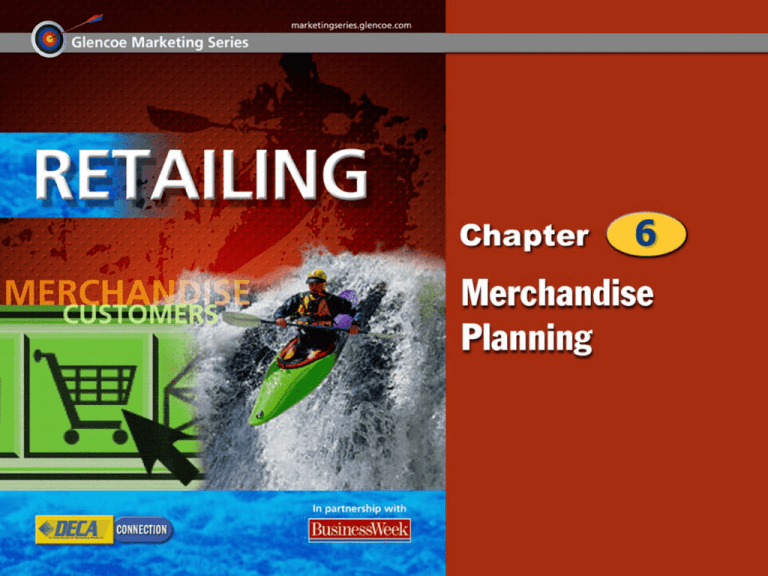
Merchandise Assortment Receiving Goods and Inventory 2 Chapter Objectives Explain merchandise plans. Describe the components of a merchandise plan. Define merchandise life cycles. Explain the receiving process. Explain the concept of inventory control. Describe inventory systems. Explain stock turnover. 3 Merchandising Decisions One of the most challenging tasks for a retailer is providing the right merchandise at the right prices—and at the right time. 4 Merchandising Decisions Before a retailer buys any merchandise for a store, he or she must make decisions and plans to make the buying process more efficient. A retailer must make decisions about what merchandise to carry and what prices to set. 5 The Merchandise Plan Retailers use a merchandise plan to make intelligent decisions before they purchase merchandise for their stores. merchandise plan a basic budgeting tool that assists the retailer or buyer in meeting departmental or classification goals 6 Merchandise Life Cycles The four stages of the merchandise life cycle are: Introduction merchandise life cycle customer-acceptance levels and buying levels of an item of merchandise Growth Acceptance Decline 7 Merchandise Assortment Planning Tools Categorizing types of merchandise is one tool retailers use to make certain they have the merchandise to satisfy their customers’ needs. Retailers also use stock lists to help plan their purchases. 8 Merchandise Assortment Planning Tools Types of merchandise are: Staple merchandise staple merchandise merchandise that sells well over a long period of time Fashion merchandise fashion merchandise merchandise that sells well for several seasons but not as long as staple merchandise Seasonal merchandise seasonal merchandise merchandise that sells well at certain times of the year Convenience merchandise convenience merchandise merchandise that is purchased by customers without much planning or thought 9 Merchandise Assortment Planning Tools Types of stock lists are: Basic stock list Model stock list Never-out list basic stock list list used for items a store should always have in stock model stock list list used for fashion merchandise never-out list list used for the most popular merchandise that should always be in stock 10 Cyber Fit Offering merchandise that customers Operating an e-tail business on an electronic channel—the crave is important for clothing retailers. Web—can be costly,Customers due to design, may delivery, come to returns, a store and operating expenses. looking for a certain dress or style. theycompanies find what they’re looking Though Many largerOnce dot-com crashed in the for, they head the fitting room. Cyclery Wait—where doNewton, you 1990’s, smallfor stores like Harris of West change clothes in an e-store? To overcome the lack of storeMassachusetts, actually increase sales using a basic Web site. Today, a third retailers of Harris’s bicycle business in on based fitting rooms, such as Lands’ Endrides use My the Web to ®get parts and personal Virtual Model , anhard-to-find online simulation model for all service. body types, measurements, and sizes. Describe an e-business’s home page to your class after For more information retailing, viewing one throughon marketingseries.glencoe.com. go to marketingseries.glencoe.com. 11 1. What are the four components of a merchandise plan? 2. Identify the four stages of the merchandise life cycle. 3. Name the three types of stock lists. 12 Receiving Merchandise Inventory must be received, checked in, marked, and handled properly. 13 Receiving Merchandise Receiving Area merchandise Check In Mark With Selling Price merchandise merchandise Move to Selling Area merchandise 14 Receiving Merchandise When retailers purchase merchandise, the purchase is recorded on a purchase order. purchase order order form that lists the style numbers of the merchandise being purchased, the amount, the delivery date, and terms of purchase The vendor sends an invoice to the retailer who has ordered the merchandise. invoice a bill for merchandise 15 Receiving Merchandise Types of checking in merchandise are: Quantity check Indirect check Quality check 16 Receiving Merchandise Merchandise must be marked with the selling price. Many retailers use Universal Product Codes (UPC). The last step in the receiving process is to move merchandise to the store’s selling area. 17 Inventory Inventory includes merchandise in the selling area; merchandise that has been purchased and is stored for future selling; and merchandise waiting to be returned to the vendor. inventory merchandise retailers have for sale 18 Inventory Control Systems Retailers can use various methods of inventory control. inventory control managing inventory levels to ensure enough merchandise to meet sales goals without having too much inventory on hand 19 Inventory Control Systems Inventory control systems include: Physical inventory system stock turnover the number of times the average inventory is sold during a time period, usually a year Perpetual inventory system Stock turnover 20 Using Inventory Methods Receiving and controlling merchandise properly ensures that the right merchandise and quantities are in stock. Retailers can reach sales goals by using tools like inventory control systems and merchandise handling. 21 1. What are the four steps in the merchandise receiving process? 2. What are the two types of inventory control methods? 3. Why is stock turnover important? 22 Checking Concepts 1. Define merchandise plan. 2. Explain the merchandise life cycle. 3. Name the four types of merchandise. 4. Compare the three types of stock lists. continued Merchandise 1. staple, 2. 3. 4. A The basic merchandise fashion, stocklife list is cycle to the plan isrefers seasonal, used fora items basic that customer budgeting convenience a store should tool that acceptance and assists the always have retailer in buying of an or buyer stock. Alevels model in meeting item oflist is used departmental stock or for merchandise. There classification goals. fashion are four stages— merchandise. A introduction, never-out listgrowth, is general acceptance, used for the most and decline. popular merchandise. 23 Checking Concepts 5. Explain the merchandise receiving process. 6. Define inventory control. 7. Describe the two types of inventory control systems. continued Most retailinventory businesses 5. It 6. 7. Physical is managing have a place set aside inventory systems physically levels to to receive and check assure count the enough in new merchandise. merchandise to the in This includes meet inventory. sales comparing thegoals without Perpetual inventory purchasehaving order totoo the much means keeping on invoice.inventory The merchandise hand.track ofis then daily marked with its that selling merchandise is price and moved received and to the area of the store merchandise that where it will be sold. is sold. 24 Checking Concepts Critical Thinking 8. Explain why retailers want a high stockturnover rate that is not too high. 8. A high stock-turnover rate means that the stock is selling quickly. However, an excessively high stockturnover rate can mean that there is not enough merchandise available to meet the planned sales goals or that certain items of merchandise are out of stock and that back orders of merchandise will result. 25 26 End of


